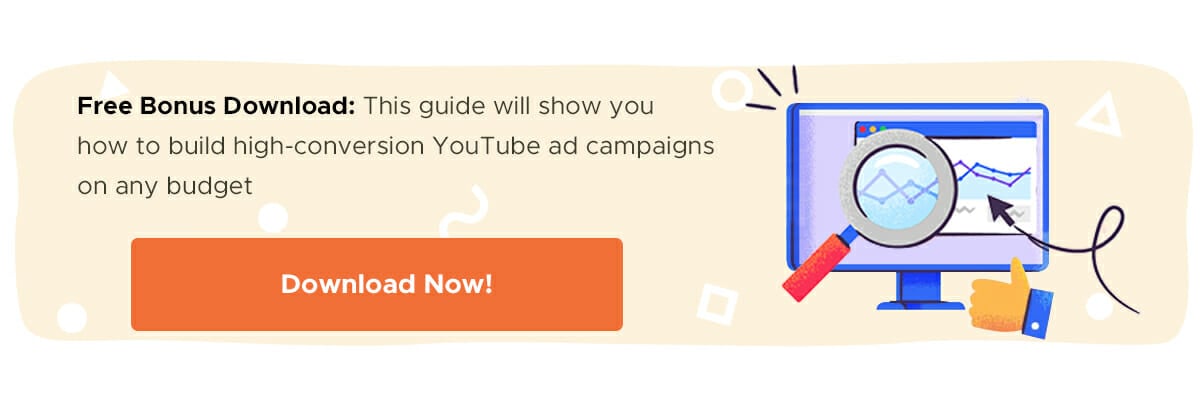To say that Amazon is an e-commerce giant is something of an understatement.
According to eMarketer data, Amazon has nearly 50% of the retail market in the United States, putting it squarely at #1 for online sales. The next three on that list — eBay, Apple and Walmart — don’ have anywhere near that number combined:
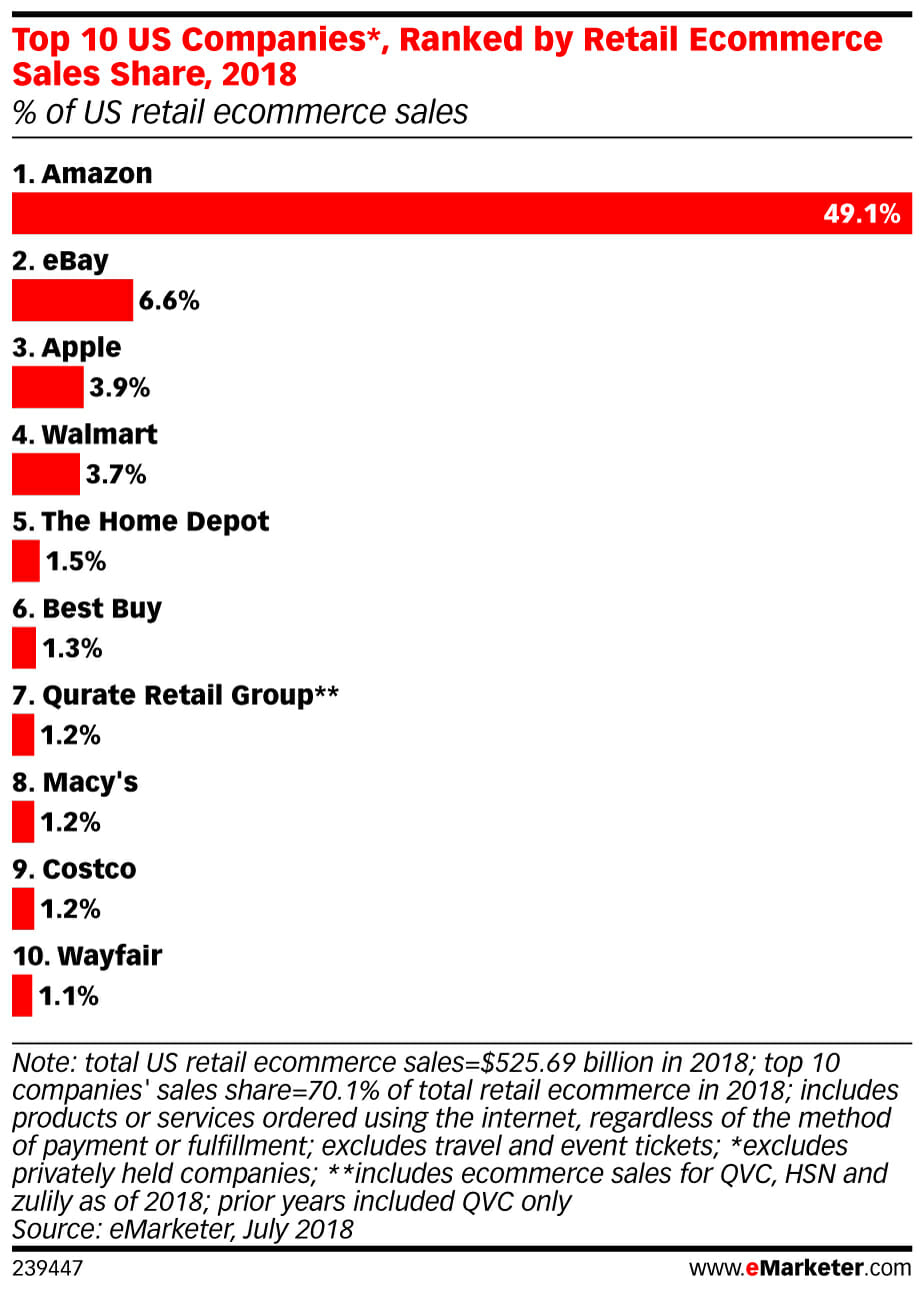
You know what else Amazon has? Data. And it’s data that anyone can use to help grow their business, whether they sell on the platform or not. What do I mean by “data”? I’m talking about product reviews.
If you sell on Amazon, you know how valuable product reviews can be. But even if you don’t, there are people in your industry who do. What you learn by reading their reviews can be an important tool for both product and content development, as well as marketing strategy.
Who Writes Amazon Reviews?
Data from Power Reviews, a company that makes rating and review software, estimates that only 5-10% of all online shoppers leave reviews. Those reviewers tend to fall into the following categories:
- People who love the product
- People who hate the product
- People who have a strong loyalty to the brand
- People who want to pay it forward (they feel that since they read reviews, it’s only fair that they add theirs to the mix to help someone else out)
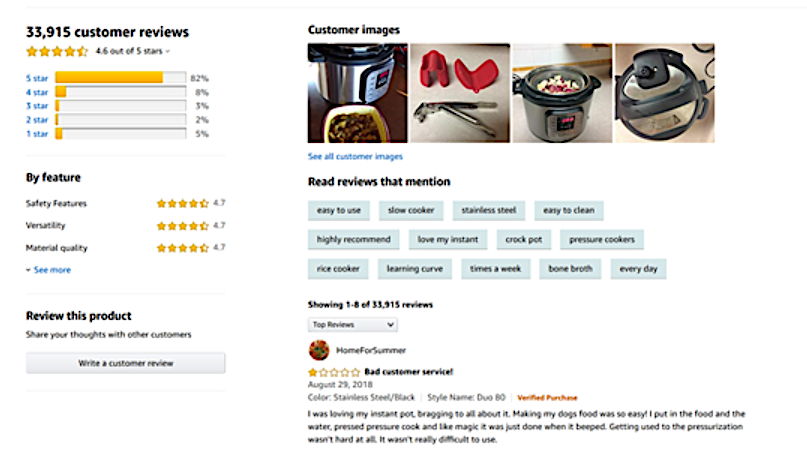
There’s a fifth category, though, and it’s an important one: people who write fake reviews. Fraudulent feedback is a huge problem on Amazon. According to Fakespot, a review analyzer company, more than 60% of Amazon reviews in the electronics, beauty and supplements categories are fake:
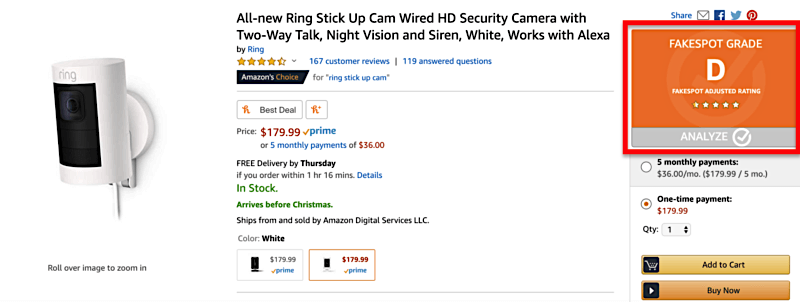
ReviewMeta is another site where you can scan a product for bogus reviews. The two sites have different algorithms for determining whether reviews are fake, so it’s a good idea to try both to get a complete picture. For example, on a pair of Letscom Bluetooth headphones that have a 4.3 rating on Amazon and 6,601 customer reviews:
- ReviewMeta gave it a FAIL and mentioned that 170 reviews have been deleted.
- Fakespot gave it a score of “D,” stating that 4,099 of the reviews for this product have been modified or deleted:
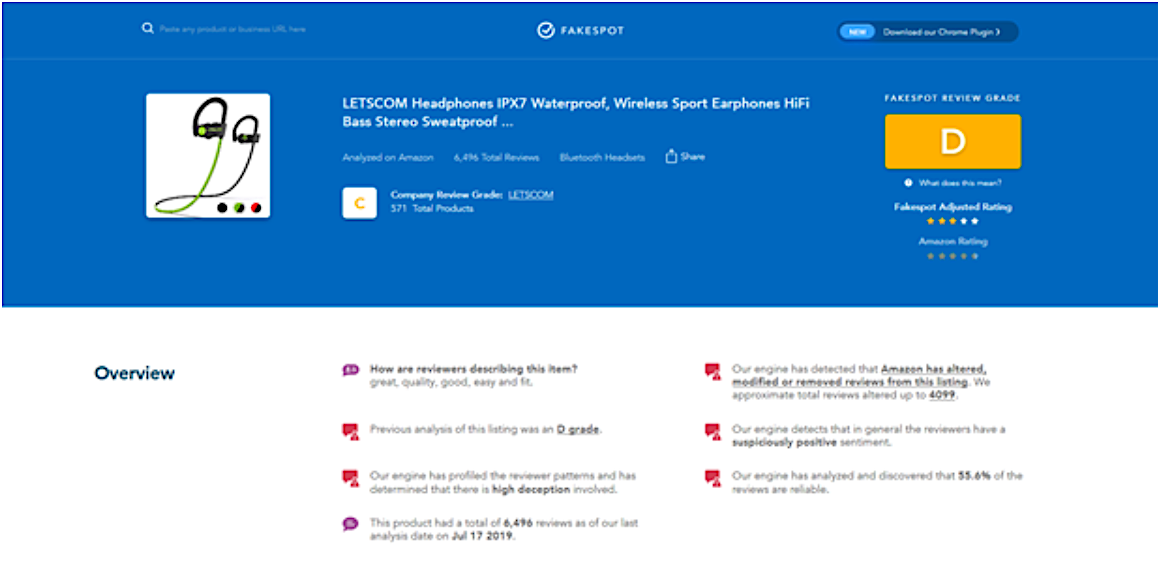
An easy way to avoid fake reviews is to stay away from the 5-star reviews completely. That’s a good idea for competitive analysis, too.
Dive Deeper:
Using Amazon Reviews to Grow Your Business
Amazon reviews of products in or related to your industry can help you create or upgrade your products, determine what content will best resonate with your audience and even hone your marketing messages. But not all reviews. Remember, people leave reviews when they love a product, hate a product or got paid to post a fake review about a product. Take those people out of the mix and you have your data set: the ones who leave 2- and 3-star reviews.
Why eliminate the first two groups? Well, the 4- and 5-star reviews don’t really tell you anything — it’s just people gushing about how great the product is. As Bill Gates once said, “Success is a lousy teacher.” Plus, those fake reviews? They’re mostly 5-star ones.
A 1-star review won’t tell you much either. It probably wasn’t written by someone who wanted to offer a nuanced account of their experience — it was written by someone who was disappointed with the product and just wanted to complain.
There are exceptions to every rule, though, so it’s a good idea to at least scan the 1-, 4- and 5-star reviews. Just know that you aren’t likely to find the most usable information there.
Once you’ve read through the reviews on competing or similar products and taken copious notes, it’s time to put those insights to work. Here’s how to do it.
Amazon Reviews for Product Development
If you currently sell products or plan to in the future, chances are your competitors are selling on Amazon. This gives you a great opportunity to discover the pain points of your competition’s customers, and use that information to make your product better.
Let’s take a product like Squatty Potty. You probably know what it is — it helps you optimize your bathroom experience.
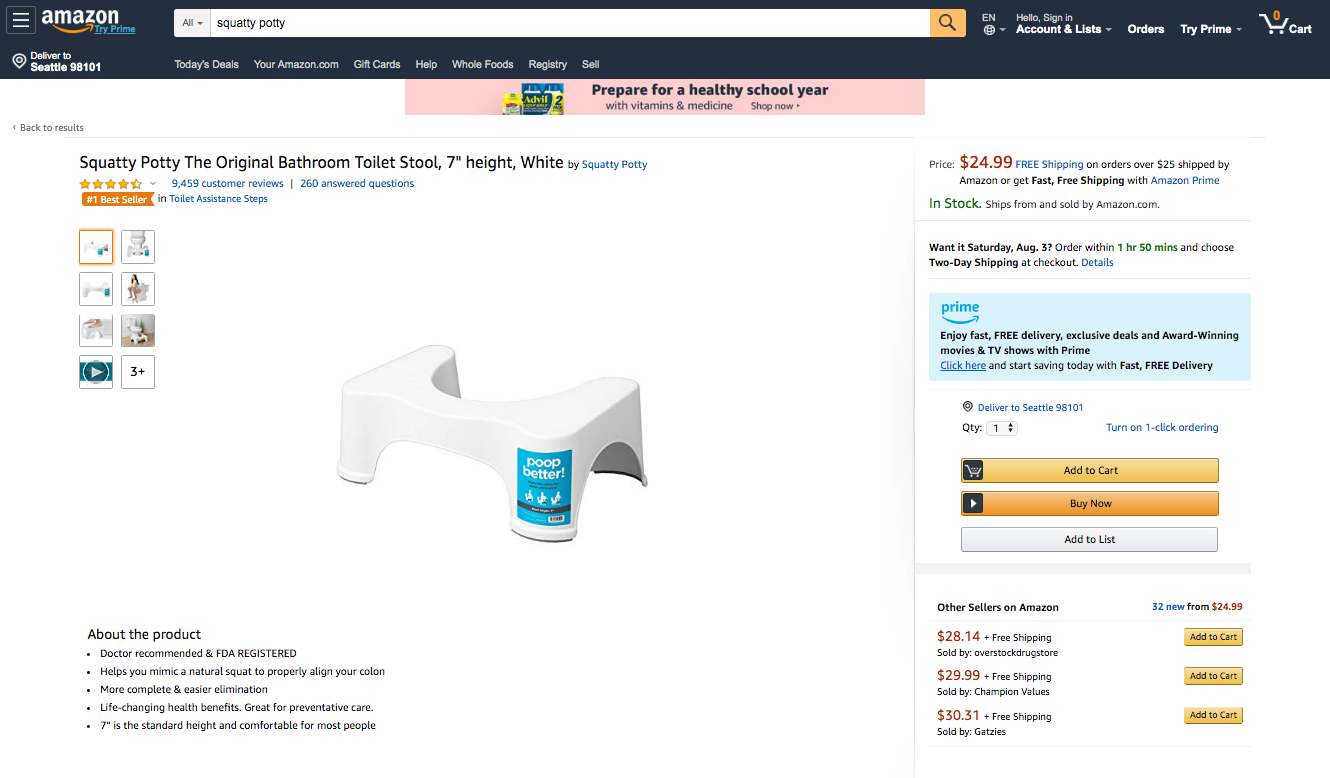
Now, let’s say you have a product or are working on a prototype of a product that does the same thing that Squatty Potty does, only better. Well, you have more than 9,000 reviews to get valuable information from, like:
- “I really wanted to love this. But my toilet is short, and I am short. It is not often that my feet fully touch the floor when sitting on the toilet. It pushes my knees WAY too high for me to be comfortable at all on the toilet.”
- “This product does exactly what it advertises. However, I find the design to be very dangerous for some users. I have a very standard toilet design, and this thing sits too far out in front of the toilet when pushed all the way back. I am a fit and healthy individual, yet I have had my balance thrown more than once while ‘backing up’ to be seated and I tripped more than once when approaching the shower in a small bathroom.”
- “My girlfriend received a 3/4″ slice along the side of her toe from the Squatty Potty when she turned from the sink to walk past the toilet.”
Feedback like this is incredibly valuable if you offer or are developing a competing product. Does your toilet step work with short people? Is it too big for small spaces? Can it pierce skin? Find out if these problems are widespread and then figure out if you can address them.
Likewise, if most of the reviews of Squatty Potty are positive and the only things people complained about were minor, then maybe think about developing a different product where there’s more of a hole in the market.
Dive Deeper:
Amazon Reviews for Content Development
Why do people buy products? To solve problems. That problem could be anything from “I don’t have a pair of jeans that fit me” to “I don’t have time to cook,” but the item they put in that cart is a solution to an issue they’re having and want to address as soon as possible. You can use knowledge gleaned from reviews of products in or adjacent to your industry to help guide your content creation.
For example, if your product is a productivity app, you can use the autosuggest feature to find keywords on Amazon. When you type in “productivity,” what comes up is “productivity habits and managing procrastination ebook.” That brings you to tons of books about procrastination. Here are some of the 2- and 3-star reviews of them:
- “The suggestions/tips themselves were utterly basic. Anyone that has struggled with procrastination will have already tried these.”
- “My biggest struggle with it has been just how much planning, thought and analysis he asks for to change the habits. That’s precisely why I procrastinate.”
- “It has great key points and suggestions. But just a revised checklist of the things mentioned would honestly suffice. The book dragged on and on and repeated itself. I appreciate the ideas, some I’ve never thought of. But all you need is the outline, basically.”
The takeaway from these reviews is that people who procrastinate want new, manageable ways to overcome it. And they aren’t getting it from the books they are reading. Creating a comprehensive guide to overcoming procrastination will help you reach those people online and promote your user-friendly app, which procrastinators will surely be interested in trying.
Amazon Reviews for Marketing
What if your product is great, but your marketing could use some work? Would you be shocked when I say that Amazon reviews will help you with that, too?
Look at the most successful products in your niche that are sold on Amazon. If those products are inferior to yours, it may be because you aren’t getting the right messages out there.
For example, there are competitors to the Instant Pot, but you’ve probably never heard of them. Why? Because Instant Pot has completely dominated the market, thanks to some very smart influencer marketing, Pinterest and a whole lot of viral luck:

But is it the best multi-cooker? When you look at the 2- and 3-star reviews, some patterns seem to emerge:
- Steep learning curve
- Unresponsive customer service
- Lack of troubleshooting information for common problems
- Lots of user error
If I had an Instant Pot competitor that was superior, I’d make sure it included better step-by-step documentation for use and troubleshooting, and I’d employ an extremely responsive support team. And then I’d market it as being easier to use and having 24/7 help available to anyone with questions or issues.
Those disgruntled Instant Pot customers who were sold on the promise of fast, simple-to-prepare meals experienced a “success gap” — the space between the customer’s desired outcome (using the Instant Pot to make mealtimes easier) and the company’s desired outcome (sell more Instant Pots).
Fill in that gap with your marketing messages and a superior product, and those customers will be yours.
Dive Deeper:
How to Use Your Reviews When You’re an Amazon Seller
If you’re an Amazon seller, you probably have customer feedback on your products. If they’re mostly positive reviews and your overall rating score is above a four, you’re in good shape.
But if you have some bad reviews that are dragging down your listings, there are a few ways to deal with it:
- Leave a comment on the review apologizing, offering to help and providing an email address the reviewer can use to get in touch. This shows other buyers that you’re willing to address problems and, more importantly, it takes the conversation to a private venue. Once you’ve resolved the situation, you can request that the customer post an update.
- If you believe a review is inaccurate or unfair, you can request that Amazon remove it.
- If you can match up any details from the review with an actual customer in your database, reach out to them. You can do this in a light-handed way if you aren’t sure it’s them, like soliciting feedback or a customer survey. If you are sure, email them. Again, once the problem is fixed, ask them to post an updated review and rating.
Also, make sure to check the sponsored products and customer-viewed products listings on your product pages frequently. Those reviews will be especially important to dive into for product and content development and marketing purposes, as those products are being pitted as direct competition to yours by Amazon.
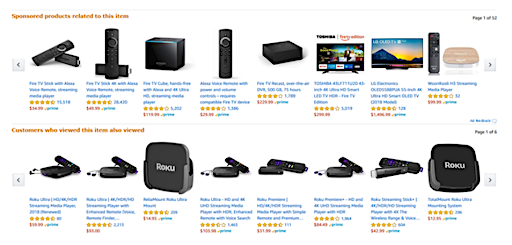
If you see the same bad reviews over and over again, it may be time to take another look at either your product, how you’re marketing it, or both. The good news is, you’ll have enough enough customer feedback and data to upgrade or launch a new product that you can be sure will meet your customers’ needs.
Dive Deeper: What Should You Do When People Complain About Your Product or Service?
Content and Product Development Through Amazon Reviews
As of April 2019, Amazon had more than 190 million products available on the platform. Even if you don’t sell physical products, you can probably find reviews of something on Amazon that will help you — be it books, apps or complementary products.
Search for the keywords that are important to your business and see what comes up. I guarantee there will be something that can help you with product development, content strategy, marketing — and maybe even all three.
